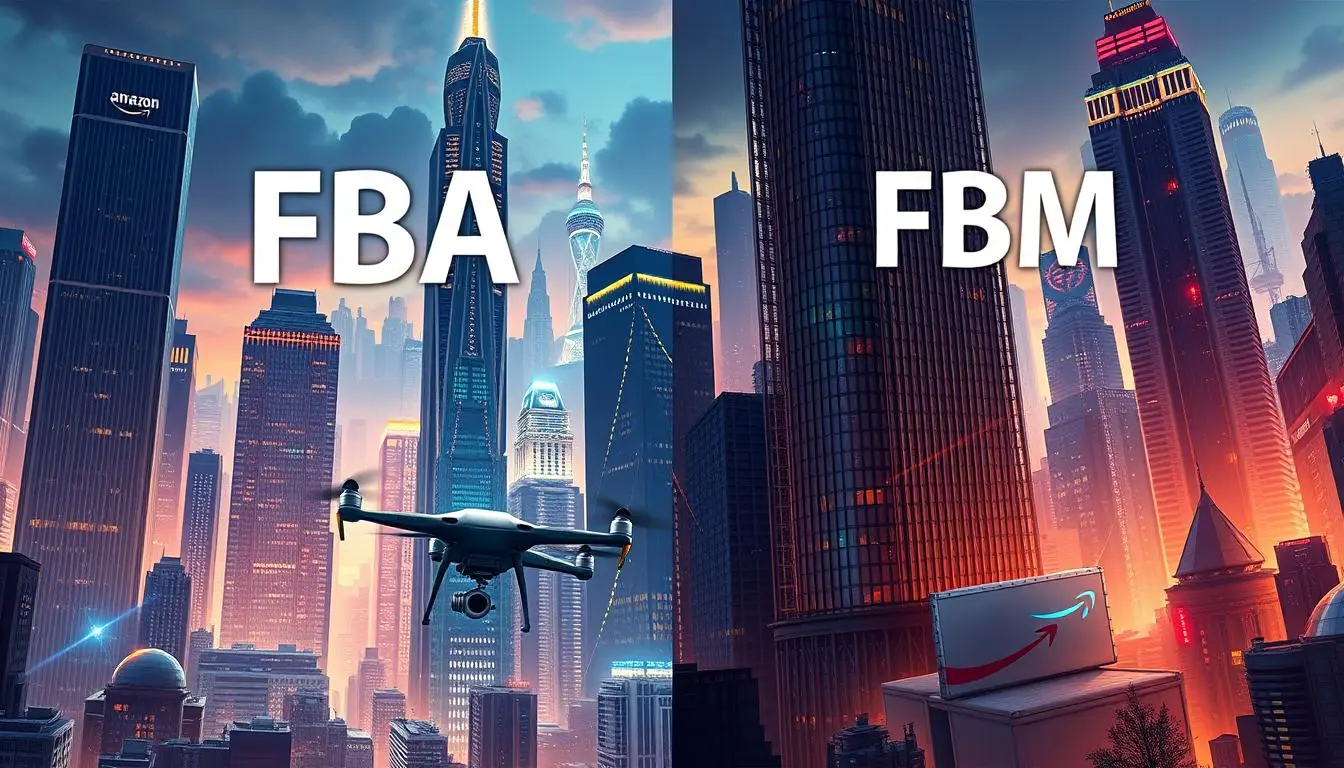“The way to get started is to quit talking and begin doing.” Walt Disney’s words capture the spirit of starting a successful Amazon business. FBA vs FBM, A key choice is whether to use Fulfillment by Amazon (FBA) or Fulfillment by Merchant (FBM).
Choosing between FBA and FBM can be tough. Amazon’s FBA makes things easy, handling storage, packaging, and shipping for you. FBM, on the other hand, lets you control the process, which can lead to more profit.
Deciding between FBA and FBM depends on several things. These include your business model, the type of products you sell, and what your customers expect. In this article, we’ll explore the good and bad of each option. This will help you choose the best for your Amazon business.
Key Takeaways
- Understanding the differences between FBA and FBM is key for success on Amazon.
- FBA is convenient and reliable, while FBM offers control and flexibility.
- Your business model and product type are important in picking the right method.
- What your customers want and shipping needs are also critical.
- Looking at the pros and cons of each will help you make a smart choice.
Understanding Amazon Fulfillment Methods
To sell on Amazon, knowing the two main fulfillment options is key. These are FBA and FBM. Each has its own way of helping you sell.
What is Amazon FBA?
FBA stands for Fulfillment by Amazon. It means that Amazon takes care of everything with regard to storage, packing, and shipping of your items. You send your products to Amazon’s warehouses. They handle everything from there.
This is very useful for sellers who want to capture the market using Amazon’s trusted and efficient logistics. You also get help from Amazon concerning customer care and returns.
Using FBA can make your product more visible. It is also eligible for Amazon Prime which can boost sales. But, remember, there are fees for FBA like storage and shipping costs.
What is Amazon FBM?
FBM or Fulfillment by Merchant means you store, pack, and ship the products yourself. You have direct control over inventory and shipping. This could mean larger profits because there is no expense paid to Amazon’s services.
FBM works well for sellers who have their own shipping setup or for those who prefer to manage their products more closely, but these sellers must ensure that they can offer the fast and reliable shipping required to satisfy their customers.
Having knowledge of FBA and FBM is key for any seller. It allows them to make a choice that best suits their business. Consider what each method brings to the table and what you need for your business.
FBA vs FBM: Key Differences Explained
Amazon sellers must know the main differences between FBA and FBM. These differences affect the seller’s experience, customer happiness, and profits.
Fulfillment Process Comparison
The way products are fulfilled is a big difference between FBA and FBM. FBA sellers send their items to Amazon’s warehouses. Amazon then takes care of storage, packaging, and shipping. On the other hand, FBM sellers handle these tasks themselves, keeping products in their own warehouses and shipping them out.
This difference impacts how efficiently things get done and how happy customers are.
- FBA: Amazon takes care of shipping, making it fast and reliable.
- FBM: Sellers manage everything themselves, giving them control but adding complexity.
Cost Structure Analysis
The costs for FBA and FBM are quite different. FBA sellers pay for storage, fulfillment, and other services, which can add up. FBM sellers, on the other hand, pay these costs themselves, handling their own logistics.
Important costs include storage fees, shipping costs, and managing returns.
Prime Eligibility Impact
FBA sellers get to be Prime eligible, making their products more attractive to Prime members. FBM sellers can also offer Prime shipping but need to use Seller Fulfilled Prime or other programs. This can be more complicated.
Control and Responsibility
FBA sellers give up some control but get Amazon’s expertise and trust. FBM sellers keep full control but have to deal with customer service and returns, which takes time.

Advantages and Disadvantages of FBA
Amazon FBA is a popular choice for sellers, but it has its ups and downs. Knowing the good and bad points is key to deciding if FBA fits your Amazon business.
Benefits of Being an FBA Seller
Being an FBA seller has many benefits. One big plus is access to Amazon’s trusted fulfillment network.
Amazon Prime Badge Access
FBA sellers get the Amazon Prime badge. This badge attracts customers who want fast and reliable shipping. It can help increase sales.
Storage and Logistics Management
Amazon takes care of storage and logistics for FBA sellers. This saves time and resources. It lets sellers focus on other business areas like inventory and shipping.
Customer Service Handling
FBA sellers also get help with customer service. Amazon handles customer questions and issues. This lets sellers focus on product development and marketing.

Limitations and Challenges
FBA has its challenges too. Knowing these can help FBA sellers manage their expectations and plan better.
FBA Fees and Costs
FBA comes with fees like fulfillment and storage fees. These can cut into profit margins.
Inventory Management Constraints
FBA sellers must follow Amazon’s inventory policies. This includes managing inventory to avoid extra fees.
Limited Control Over Fulfillment
FBA offers convenience but limits seller control over the fulfillment process. This can be a problem for sellers who want direct control over their products and customer interactions.
In summary, FBA has benefits like Amazon Prime access, efficient logistics, and customer service help. But, it also has downsides like fees, inventory management rules, and less control over fulfillment. Knowing these points is key to deciding if FBA is right for your Amazon business.
Advantages and Disadvantages of FBM
Choosing FBM on Amazon means weighing its pros and cons. These include costs, control, and customer service duties. FBM, or Fulfillment by Merchant, lets sellers manage their products’ storage, packaging, and shipping.
Benefits of Merchant Fulfillment
Merchant fulfillment has many benefits for Amazon sellers. A key advantage is greater control over shipping. This lets sellers manage their logistics better.
Greater Control Over Shipping
FBM gives sellers the freedom to pick their shipping carriers and methods. This can cut down shipping times and costs. It’s great for sellers with good relationships with shipping providers.
Lower Direct Costs
FBM can lead to lower direct costs for sellers. They don’t have to pay Amazon’s fulfillment fees. This is a big plus for sellers with large or heavy items.
Inventory Flexibility
FBM lets sellers manage their inventory more flexibly. They can store products in different places. This can lower storage costs and reduce reliance on Amazon’s centers.
Limitations and Challenges
FBM has its own set of challenges. Sellers need to think about the drawbacks, like Amazon Prime restrictions.
Prime Badge Restrictions
One big limitation of FBM is the Amazon Prime badge restriction. Sellers must meet Amazon’s Prime shipping standards to keep the badge.
Operational Burden
FBM puts a big operational burden on sellers. They handle all fulfillment tasks, like storage, packaging, and customer service. This can be time-consuming and may need more resources.
Customer Service Responsibilities
Sellers with FBM also handle customer service for their orders. This can be tough, mainly for big sellers or those with few customer service resources.

Factors to Consider When Choosing Between FBA and FBM
Choosing the right fulfillment method for your Amazon business is key. FBA and FBM have different benefits that can affect your business’s success. Think about these important factors before making a decision.
Product Characteristics
The type of products you sell is very important. For example, perishable goods or fragile items need special care. FBM might be better if you can handle storage and shipping well.
Business Size and Scale
How big your business is also matters. Big businesses with lots of sales might do well with FBA. It’s good at handling lots of items. But, smaller businesses might like FBM to keep control over their stuff.

Profit Margins and Fee Considerations
It’s important to know the fees for both FBA and FBM. FBA has storage, fulfillment, and removal fees that can cut into your profits. FBM means you pay for shipping and handling yourself.
Seasonal Fluctuations
If your business changes with the seasons, think about how you’ll handle it. FBA is great for busy times because it can grow with you. But, it might cost more if you have too much stuff after the busy time.
Hybrid Approach: When to Use Both Methods
Some sellers use a hybrid approach with FBA and FBM. This way, you can adapt to different products or busy times. It helps you save money and work more efficiently.
| Fulfillment Method | Best For | Key Considerations |
|---|---|---|
| FBA | Large businesses, products with high demand | Storage fees, fulfillment fees, scalability |
| FBM | Small businesses, fragile or perishable goods | Shipping costs, handling control, inventory management |
| Hybrid | Businesses with varied product lines or seasonal fluctuations | Flexibility, cost optimization, inventory control |
Making the Right Choice for Your Amazon Business
Choosing between Amazon FBA and FBM depends on understanding their differences. As an fba seller, using amazon fba meaning – Fulfillment by Amazon – can make your business run smoother. It offers benefits like Prime eligibility and trusted customer service.
When deciding, think about your products, business size, and profit margins. Look at the pros and cons of each method. Also, consider if you can handle storage, packaging, and shipping on your own. For some, a mix of FBA and FBM might work best.
The best choice depends on matching your fulfillment method with your business goals and what you can do. By carefully looking at your needs and each option, you can make a smart choice. This choice will help your business grow and succeed in the Amazon marketplace.





